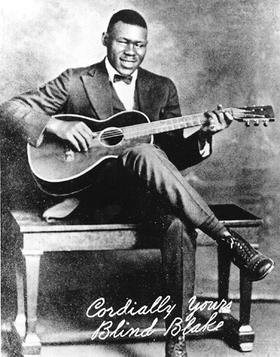Blind Blake facts for kids
Quick facts for kids
Blind Blake
|
|
|---|---|

The only known photograph of Blake, ca. 1927
|
|
| Background information | |
| Birth name | Arthur Blake |
| Also known as | Blind Blake |
| Born | 1896 Jacksonville, Florida, or Newport News, Virginia, United States (uncertain) |
| Died | December 1, 1934 (aged 37–38) Milwaukee, Wisconsin, U.S. |
| Genres | |
| Instruments |
|
| Associated acts | Irene Scruggs |
Arthur Blake (born 1896 – died December 1, 1934), known as Blind Blake, was an American blues and ragtime singer and guitarist. He is famous for the many recordings he made for Paramount Records between 1926 and 1932.
Contents
Who Was Blind Blake?
Not much is known about Arthur Blake's early life. Records from Paramount Records said he was born blind in Jacksonville, Florida. He seemed to live there at different times. Some people thought he might have family in Patterson, Georgia.
In 2011, a group of researchers found his death certificate from 1934. This paper said he was born in 1896 in Newport News, Virginia. His parents were Winter and Alice Blake. We don't know much else about him until the 1920s, when he became a recording musician.
His Music Career
Blind Blake recorded about 80 songs for Paramount Records from 1926 to 1932. He was one of the most talented guitar players of his time. He played many different kinds of music. He is best known for his special guitar playing style. It sounded a lot like ragtime piano music.
Blake likely lived in Jacksonville and traveled to Chicago for his recording sessions. He would often go back to Florida for the winter. In the 1930s, people said he was playing music in front of a hotel in Jacksonville.
His Unique Guitar Style
Blind Blake's first songs were recorded in 1926, and they sold very well. His first solo record had "Early Morning Blues" on one side and "West Coast Blues" on the other. Both songs are great examples of his ragtime-based guitar style. They also helped create the Piedmont blues sound.
His complex and detailed fingerpicking style inspired many other guitarists. These included Reverend Gary Davis, Ry Cooder, and Leon Redbone. The famous musician Big Bill Broonzy heard Blake play in the early 1920s. He said Blake made his guitar sound like a whole band. Broonzy added that he had never seen anyone play as much guitar with just their fingers as Blind Blake.
Later Life and Passing
Blind Blake married Beatrice McGee around 1931. In 1932, he made his last recordings at the Paramount headquarters in Grafton, Wisconsin. This was just before the record company closed down.
For many years, no one knew what happened to him after that. Some thought he had a bad end. However, research shows that Blake stayed in Wisconsin. He lived in the Milwaukee area where Paramount often housed its artists. He didn't seem to find work as a musician.
In April 1933, he became very sick with a lung illness and never fully got better. On December 1, 1934, after being sick for three weeks, he passed away on the way to the hospital. He was buried in Glen Oaks Cemetery in Glendale, Wisconsin.
His Legacy
Blind Blake's music continues to be important. His songs have been collected on many albums over the years.
The song "You Gonna Quit Me" from Bob Dylan's 1992 album Good as I Been to You is a cover of Blind Blake's "You Gonna Quit Me Blues."
Blake also appears in books and TV shows. He is a character in Lee Child's Jack Reacher novels, like Killing Floor. He is also mentioned in the TV series Reacher, which is based on those books. The main character, Jack Reacher, is a big fan of blues music and looks for traces of Blake.
See also
 In Spanish: Blind Blake para niños
In Spanish: Blind Blake para niños

